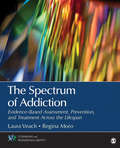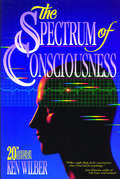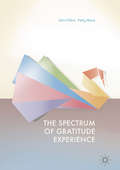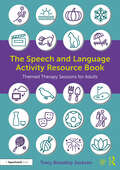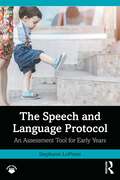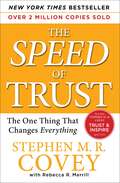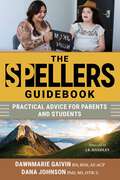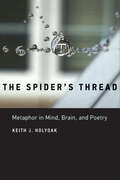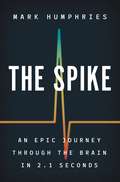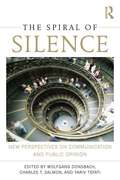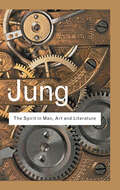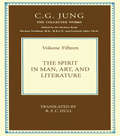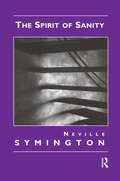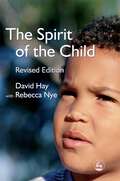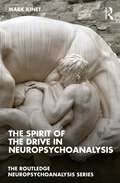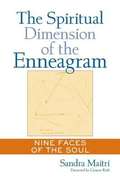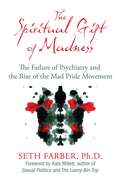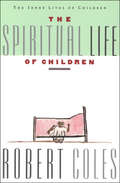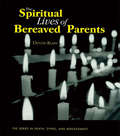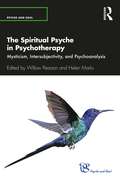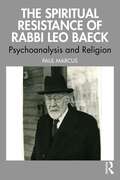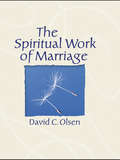- Table View
- List View
The Spectrum of Addiction: Evidence-Based Assessment, Prevention, and Treatment Across the Lifespan (Counseling and Professional Identity)
by Laura J. Veach Regina R. MoroReflecting the latest content in the DSM–5, The Spectrum of Addiction presents a comprehensive overview of addictive behaviors and habits from early use through risky use, severe-risk use, and addiction. Authors Laura Veach and Regina Moro draw from their experience in both teaching and counseling to provide real-world knowledge and evidence-based practices for working with clients who fall within the spectrum of addiction ranging from experimentation to physical addiction and recovery. With a unique focus on neuroscience, integration of CACREP standards, and extensive coverage of addictions across the lifespan, the book serves as a practical resource for future addiction counselors. The Spectrum of Addiction is part of SAGE’s Counseling and Professional Identity Series.
The Spectrum of Addiction: Evidence-Based Assessment, Prevention, and Treatment Across the Lifespan (Counseling and Professional Identity)
by Laura J. Veach Regina R. MoroReflecting the latest content in the DSM–5, The Spectrum of Addiction presents a comprehensive overview of addictive behaviors and habits from early use through risky use, severe-risk use, and addiction. Authors Laura Veach and Regina Moro draw from their experience in both teaching and counseling to provide real-world knowledge and evidence-based practices for working with clients who fall within the spectrum of addiction ranging from experimentation to physical addiction and recovery. With a unique focus on neuroscience, integration of CACREP standards, and extensive coverage of addictions across the lifespan, the book serves as a practical resource for future addiction counselors. The Spectrum of Addiction is part of SAGE’s Counseling and Professional Identity Series.
The Spectrum of Consciousness
by Ken WilberWilber's groundbreaking synthesis of religion, philosophy, physics, and psychology started a revolution in transpersonal psychology. He was the first to suggest in a systematic way that the great psychological systems of the West could be integrated with the noble contemplative traditions of the East. Spectrum of Consciousness, first released by Quest in 1977, has been the prominent reference point for all subsequent attempts at integrating psychology and spirituality."Wilber might likely do for consciousness what Freud did for psychology,"---Dr. Jean Houston, author of The Possible Human,Godseed and Life Force .
The Spectrum of Consciousness
by Ken WilberWilber's groundbreaking synthesis of religion, philosophy, physics, and psychology started a revolution in transpersonal psychology. He was the first to suggest in a systematic way that the great psychological systems of the West could be integrated with the noble contemplative traditions of the East. Spectrum of Consciousness, first released by Quest in 1977, has been the prominent reference point for all subsequent attempts at integrating psychology and spirituality.
The Spectrum of Gratitude Experience
by John Elfers Patty HlavaDrawing from current research in psychology, the social sciences, and spirituality, this book presents a comprehensive investigation into the heart of gratitude as it arises within lived experience and its role in nurturing relationships. It explores the range and depth of the emotion experience of gratitude and identifies its relationship with other indicators of wellbeing. New research by the authors reveals gratitude as a feature of transcendence and its connection to higher order experience including spirituality and religion. This book explores the potential for cultivating gratitude as a transformative practice for personal growth, enhancing relationships, and spiritual development.
The Speech and Language Activity Resource Book: Themed Therapy Sessions for Adults
by Tracy Broadley JacksonThe Speech and Language Activity Resource Book offers a flexible and readily available set of activities and worksheets designed to support speech and language therapists as they deliver personalised and engaging therapy sessions. With topics based on seasons, hobbies, sports and celebrations, etc, the worksheets can be selected to suit a client’s interests as well as targeting specific skills and needs. The engaging activities encourage conversation and participation, promoting skill development in a way that is easily translated into everyday communication. Key features of this book include: A range of activities, arranged by level of difficulty, that can be selected based on the client’s individual need A person-centred approach to therapy, enabling the time-poor practitioner the opportunity to personalise their care with ease Photocopiable and downloadable sheets that can be completed during therapy sessions or sent out to the client for home practice, as well as blank worksheets that can be used to create new, appropriate activities Easily adaptable for group sessions, one-on-one therapy sessions and home activities, this is an essential tool for speech and language therapists and occupational therapists, as well as families and other practitioners supporting adults with a range of acquired communication difficulties.
The Speech and Language Protocol: An Assessment Tool for Early Years
by Stephanie LoPrestiThis valuable book addresses the common problems faced by speech‑language pathologists, offering solutions and strategies for more effective service delivery.Stephanie LoPresti introduces ‘The Protocol,’ a child development‑based approach that merges principles from developmental psychology and speech‑language pathology. The book covers a wide range of speech and language issues, including receptive, expressive, pragmatic, feeding, and play development, making it a versatile resource for clinicians. It is designed to be easy to use, with movable elements that adapt to a child’s progress from short‑ to long‑term milestones and goals. It emphasizes the concept of the zone of proximal development, ensuring that clinicians work with clients just above their current level of functioning, leading to meaningful progress.Accompanied by downloadable worksheets to assess progress, it will be an essential resource for all speech and language pathologists, particularly those working with young children. It will also be useful to students and educators in the field of speech‑language pathology seeking evidence‑based strategies for working with clients, as well as healthcare professionals, researchers, and educators interested in child development and language acquisition.
The Speed of Trust: The One Thing that Changes Everything
by Rebecca R. Merrill Stephen M. R. CoveyFrom Stephen R. Covey's eldest son comes a revolutionary new path towards productivity and satisfaction. Trust, says Stephen M. R. Covey, is the very basis of the new global economy, and he shows how trust--and the speed at which it is established with clients, employees and constituents--is the essential ingredient for any high-performance, successful organization. For business leaders and public figures in any arena, The Speed of Trust offers an unprecedented and eminently practical look at exactly how trust functions in our every transaction and relationship--from the most personal to the broadest, most indirect interaction--and how to establish trust immediately so that you and your organization can forgo the time-killing, bureaucratic check-and-balance processes so often deployed in lieu of actual trust.
The Spellers Guidebook: Practical Advice for Parents and Students
by Dana Johnson Dawnmarie GaivinA means by which thousands, and soon millions, of people are being freed from their lives of silence. The Spellers Guidebook is the first of its kind—a comprehensive guidebook that every family should take along for their Spelling journey. From the moment you first learn about spelled communication through working with a practitioner, developing fluency, and everything in between, this book serves as a blueprint to follow while you build the skills to spell openly with your child. The Spellers Guidebook is informative not only for parents and caregivers but for practitioners and professionals as well. It answers questions from the most basic—what to expect during the first spelling session, to more clinical—what is apraxia, and how does it affect my speller? It even discusses the importance of regulation and how the interpersonal dynamic between the speller and their communication partner can impact flow. The journey toward open communication differs for every family, and this handbook is here to help remove any guesswork. Whether your path seems straight and easy to navigate or the road ahead appears winding and twisting, Dana and DM are here to guide you. If you walk away with nothing more than the confidence that you can do this with your nonspeaker (because you CAN), The Spellers Guidebook has done its job!
The Spider's Thread: Metaphor in Mind, Brain, and Poetry (The\mit Press Ser.)
by Keith J. HolyoakAn examination of metaphor in poetry as a microcosm of the human imagination—a way to understand the mechanisms of creativity.In The Spider's Thread, Keith Holyoak looks at metaphor as a microcosm of the creative imagination. Holyoak, a psychologist and poet, draws on the perspectives of thinkers from the humanities—poets, philosophers, and critics—and from the sciences—psychologists, neuroscientists, linguists, and computer scientists. He begins each chapter with a poem—by poets including Samuel Taylor Coleridge, Sylvia Plath, Walt Whitman, Emily Dickinson, Robert Frost, Theodore Roethke, Du Fu, William Butler Yeats, and Pablo Neruda—and then widens the discussion to broader notions of metaphor and mind. Holyoak uses Whitman's poem “A Noiseless Patient Spider” to illustrate the process of interpreting a poem, and explains the relevance of two psychological mechanisms, analogy and conceptual combination, to metaphor. He outlines ideas first sketched by Coleridge—who called poetry “the best words in their best order”—and links them to modern research on the interplay between cognition and emotion, controlled and associative thinking, memory and creativity. Building on Emily Dickinson's declaration “the brain is wider than the sky,” Holyoak suggests that the control and default networks in the brain may combine to support creativity. He also considers, among other things, the interplay of sound and meaning in poetry; symbolism in the work of Yeats, Jung, and others; indirect communication in poems; the mixture of active and passive processes in creativity; and whether artificial intelligence could ever achieve poetic authenticity. Guided by Holyoak, we can begin to trace the outlines of creativity through the mechanisms of metaphor.
The Spike: An Epic Journey Through the Brain in 2.1 Seconds
by Mark HumphriesThe story of a neural impulse and what it reveals about how our brains workWe see the last cookie in the box and think, can I take that? We reach a hand out. In the 2.1 seconds that this impulse travels through our brain, billions of neurons communicate with one another, sending blips of voltage through our sensory and motor regions. Neuroscientists call these blips “spikes.” Spikes enable us to do everything: talk, eat, run, see, plan, and decide. In The Spike, Mark Humphries takes readers on the epic journey of a spike through a single, brief reaction. In vivid language, Humphries tells the story of what happens in our brain, what we know about spikes, and what we still have left to understand about them.Drawing on decades of research in neuroscience, Humphries explores how spikes are born, how they are transmitted, and how they lead us to action. He dives into previously unanswered mysteries: Why are most neurons silent? What causes neurons to fire spikes spontaneously, without input from other neurons or the outside world? Why do most spikes fail to reach any destination? Humphries presents a new vision of the brain, one where fundamental computations are carried out by spontaneous spikes that predict what will happen in the world, helping us to perceive, decide, and react quickly enough for our survival.Traversing neuroscience’s expansive terrain, The Spike follows a single electrical response to illuminate how our extraordinary brains work.
The Spiral of Silence: New Perspectives on Communication and Public Opinion
by Wolfgang Donsbach Charles T. Salmon Yariv TsfatiSince its original articulation in the early 1970s, the 'spiral of silence' theory has become one of the most studied theories of communication and public opinion. It has been tested in varied sociopolitical contexts, with different issues and across communication systems around the world. Attracting the interest of scholars from communication, political science, sociology, public opinion and psychology, it has become both the subject of tempestuous academic debate as well as a mainstay in courses on communication theory globally. Reflecting substantial new thinking, this collection provides a comprehensive examination of the spiral of silence theory, offering a synthesis of prior research as well as a solid platform for future study. It addresses various ideological and methodological criticisms of the theory, links the theory with allied areas of scholarship, and provides analyses of empirical tests. Contributors join together to present a breadth of disciplinary and international perspectives. As a distinctive and innovative examination of this influential theory, this volume serves as a key resource for future research and scholarship in communicaiton, public opinion, and political science.
The Spirit in Man, Art and Literature (Routledge Classics)
by C.G. JungThe Spirit in Man, Art and Literature offers unique and penetrating insights into the lives and opinions of some of the most significant players in the cultural life of the twentieth century. Carl Gustav Jung was at the heart of that cultural life, pioneering, along with Freud, a new interpretation of what it meant to be human in the modern age. This volume reveals the full range of Jung's involvement in this process, from his famous analysis of 'Psychology and Literature' to his landmark texts on Joyce's Ulysses and Picasso's paintings. Jung writes of Freud from the perspective of one who was "permitted a deep glimpse into the mind of this remarkable man," and through the memories and opinions recorded in The Spirit in Man, Art and Literature, the reader is offered a similar privilege.
The Spirit of Man in Art and Literature: Spirit In Man, Art, And Literature (Collected Works of C. G. Jung #5)
by C.G. JungFirst published in 1967. There are different ways of looking at the achievements of outstanding personalities. In reading this book, the reader will be in touch with some of Jung's best insights into artistic and literary creation. The essays are on Paracelsus, Freud, Richard Wilhelm, Picasso, and Joyce's Ulysses. There are also two chapters on poetry and literature.
The Spirit of Sanity
by Neville SymingtonA rare and unusual consideration of the spiritual dimensions of sanity from a psychoanalytic perspective, this transcription of a series of seven lectures delivered at the Tavistock Clinic capture the spontaneity and immediacy of the interplay between one of the world's most eminent psychoanalysts and an audience of his peers. The author of the established psychoanalytic classics Emotion and Spirit, Narcissism: A New Theory; and The Analytic Experience here brings his characteristic insight and innovation to the question of how the traditional Freudian view of religious belief as neurotic or illusory can be reconciled with a way of taking up psychoanalytic work without abandoning the spiritual dimension to life.
The Spirit of the Child: Revised Edition
by David HaySpirituality is increasingly acknowledged to be an essential part of child development. David Hay argues for the inclusion of spiritual awareness as a cross-curricular element in the school syllabus to promote the development of morality and social cohesion. While culturally constructed pressures and the decline in institutional religion have led to the suppression of spiritual expression, children are, the author maintains, capable of profound and meaningful beliefs from an early age. A three-year research study into young children's spirituality and its survival value informs Hay's view that spirituality in education needs to overcome traditional approaches and should adopt a theory of spirituality that includes religion but is not confined to it. This stimulating book will encourage educators, parents and others involved in teaching children to consider new approaches to foster children's natural spiritual development.
The Spirit of the Drive in Neuropsychoanalysis (The Routledge Neuropsychoanalysis Series)
by Mark KinetThe Spirit of the Drive in Neuropsychoanalysis gives a concise introduction to the basics of neuropsychoanalysis, both theoretically and clinically. Kinet uses a colloquial approach to discuss topics such as the dynamic and descriptive unconscious, dream theory, homeostasis, affect and awareness, pleasure and jouissance, the signifier and the drive. Throughout the volume, Kinet is informed by the field-defining work of Mark Solms and Ariane Bazan and their respective Freudian or Lacanian origins. Asking questions on the relevance of neuropsychoanalysis in a clinical setting, this book offers vital insight into how analysts can bring this field into their day-to-day work with clients. Clinical and other interludes illustrate and illuminate the matter from the perspective of the psychoanalyst at work. Written in an accessible style and part of The Routledge Neuropsychoanalysis Series, this volume will interest both those experienced with neuropsychoanalysis and those approaching the topic for the first time.
The Spiritual Brain: A Neuroscientist's Case for the Existence of the Soul
by Denyse O'Leary Mario BeauregardDo religious experiences come from God, or are they merely the random firing of neurons in the brain? Drawing on his own research with Carmelite nuns, neuroscientist Mario Beauregard shows that genuine, life-changing spiritual events can be documented. He offers compelling evidence that religious experiences have a nonmaterial origin, making a convincing case for what many in scientific fields are loath to consider—that it is God who creates our spiritual experiences, not the brain. Beauregard and O'Leary explore recent attempts to locate a "God gene" in some of us and claims that our brains are "hardwired" for religion—even the strange case of one neuroscientist who allegedly invented an electromagnetic "God helmet" that could produce a mystical experience in anyone who wore it. The authors argue that these attempts are misguided and narrow-minded, because they reduce spiritual experiences to material phenomena. Many scientists ignore hard evidence that challenges their materialistic prejudice, clinging to the limited view that our experiences are explainable only by material causes, in the obstinate conviction that the physical world is the only reality. But scientific materialism is at a loss to explain irrefutable accounts of mind over matter, of intuition, willpower, and leaps of faith, of the "placebo effect" in medicine, of near-death experiences on the operating table, and of psychic premonitions of a loved one in crisis, to say nothing of the occasional sense of oneness with nature and mystical experiences in meditation or prayer. Traditional science explains away these and other occurrences as delusions or misunderstandings, but by exploring the latest neurological research on phenomena such as these, The Spiritual Brain gets to their real source.
The Spiritual Dimension of the Enneagram
by Sandra MaitriA groundbreaking exploration of the spiritual dimension of working with the enneagram by one of its earliest students and teachers in America.Here is one of the first books to explore in an authentic and comprehensive way the original spiritual dimension of the enneagram. Among the most knowledgeable teachers of the enneagram in America, Sandra Maitri shows how the enneagram not only reveals our personalities, but illuminates a basic essence within each of us. She shows how traversing the inner territory particular to our ennea-type can bring us profound fulfillment and meaning, as well as authentic spiritual development.
The Spiritual Gift of Madness: The Failure of Psychiatry and the Rise of the Mad Pride Movement
by Kate Millett Seth FarberA bold call for the “insane” to reclaim their rightful role as prophets of spiritual and cultural transformation • Explains how many of those diagnosed as schizophrenic, bipolar, and other forms of “madness” are not ill but experiencing a spiritual awakening • Explores the rise of Mad Pride and the mental patients’ liberation movement • Reveals how those seen as “mad” must embrace their spiritual gifts to help the coming global spiritual transition Many of the great prophets of the past experienced madness--a breakdown followed by a breakthrough, spiritual death followed by rebirth. With the advent of modern psychiatry, the budding prophets of today are captured and transformed into chronic mental patients before they can flower into the visionaries and mystics they were intended to become. As we approach the tipping point between extinction and global spiritual awakening, there is a deep need for these prophets to embrace their spiritual gifts. To make this happen, we must learn to respect the sanctity of madness. We need to cultivate Mad Pride. Exploring the rise of Mad Pride and the mental patients’ liberation movement as well as building upon psychiatrist R. D. Laing’s revolutionary theories, Seth Farber, Ph.D., explains that diagnosing people as mad has more to do with social control than therapy. Many of those labeled as schizophrenic, bipolar, and other kinds of “mad” are not ill but simply experiencing different forms of spiritual awakening: they are seeing and feeling what is wrong with society and what needs to be done to change it. Farber shares his interviews with former schizophrenics who now lead successful and inspiring lives. He shows that it is impossible for society to change as long as the mad are suppressed because they are our catalysts of social change. By reclaiming their rightful role as prophets of spiritual and cultural revitalization, the mad--by seeding new visions for our future--can help humanity overcome the spiritual crisis that endangers our survival and lead us to a higher and long-awaited stage of spiritual development.
The Spiritual Life of Children
by Robert ColesA look at faith through the voices of children from varied religious backgrounds, by the Pulitzer-winning author of The Moral Intelligence of Children. A New York Times Notable Book What do children think about when they consider God, Heaven and Hell, the value of life in the here and now, and the inevitability of death? Child psychiatrist, Pulitzer Prize-winning writer, and Harvard professor Robert Coles spent thirty years interviewing hundreds of children—from South America and Europe to Africa and the Middle East—who are developing concepts of faith even as they struggle to understand its contradictions. Be they Catholic or Protestant, Jewish children from Boston, Pakistani children in London, agnostics, Native Americans, or young Christians in the American South, they offer honest, enlightening and sometimes startling ideas of a spiritual existence. A Hopi girl who knows for a fact that we are resurrected as birds; an African American child who believes God exists as a hurricane to &“blow away&” drug dealers; a young Christian who needs his faith to cope with the death of his sister, lest she be just &“a big heartache to us till the day we die&”; and a Tennessee child who rationalizes his belief by admitting that &“if there's no God, that's all there is, ashes.&” The Spiritual Life of Children is &“a remarkable book. The generosity of vision that characterizes Dr. Coles's enterprise enables him to create a climate where words of great beauty and truthfulness can be spoken.&” —The New York Times
The Spiritual Lives of Bereaved Parents (Series in Death, Dying, and Bereavement)
by Dennis KlassThis book describes how parents lose, find, or relocate spiritual anchors after the death of their child. It describes how ordinary people reconstruct their lives after their foundations have shifted, and how they make sense of their world after one of their centers of meaning has been removed. Klass grounds his descriptions of spirituality in his scholarly study of comparative religions, and in his two decades studying the lives of bereaved parents. He argues that continuing bonds with their dead children can give parents a new transcendent reality. Deceased children, like saints or bodhisattvas, can offer a bridge between the profane and sacred worlds, support parents as they find meaning in a world made forever poorer, and bind together a community adequate to parents' grief. The book reports Klass's clinical practice and his work as advisor to a bereaved parents self-help support group.
The Spiritual Psyche in Psychotherapy: Mysticism, Intersubjectivity, and Psychoanalysis (Psyche and Soul)
by Willow Pearson Helen MarloThis book examines the interaction of spiritual and psychoanalytic lineages with psychotherapy in everyday practice. Written by a team of seasoned clinicians and illustrated through clinical vignettes, chapters explore topics pertaining to the mystical dimensions of psychological and spiritual life and how it may be integrated into clinical practice. Topics discussed include dreams, dissociation, creativity, therapeutic relationship, free association, transcendence, poetry, paradox, doubleness, loss, death, grief, mystery, embodiment and soul. The authors, clinicians with decades of experience in psychotherapy, psychoanalysis and spiritual practice, draw from their deep engagement with spirituality and psychoanalysis, focusing on a particular theme and its application to clinical work that is supported by the generative conversation among these lineages. At once applied and theoretical, this book weaves insights from the heart of Vajrayana Buddhism, Zen Buddhism, Christianity, Catholicism, Ecumenicism, Integral Spirituality, Judaism, Kaballah, Non-violence, Sufism and Vedanta. They are in conversation with psychoanalytic perspectives including Jungian, Post-Jungian, Winnicottian, Bionian, Post-Bionian and Relational. A felt sense of the spiritual psyche in clinical practice emerges from this conversation among spiritual and psychoanalytic lineages, beckoning clinicians ever further on the path of spiritually rooted, psychodynamic practice.
The Spiritual Resistance of Rabbi Leo Baeck: Psychoanalysis and Religion
by Paul MarcusThe Spiritual Resistance of Rabbi Leo Baeck provides an overview of the life of Dr. Leo Baeck (1873–1956), a German-Jewish rabbi, theologian, historian and Holocaust survivor, from a psychoanalytic perspective.Paul Marcus approaches Baeck’s life and intellectual/theological contribution as it interfaces with a broadly defined psychoanalysis. This book describes and explains how Baeck maintained the rudiments of his autonomy, integration and humanity while remaining in Nazi Germany and while in the ghetto Theresienstadt, displaying astonishing courage, character, and goodness—a triumph of a civilized person amidst Nazi brutality. Marcus also considers psychic resilience and moral psychology and assesses contemporary criticisms of Baeck.The Spiritual Resistance of Rabbi Leo Baeck will be of interest to academics and scholars of psychoanalytic studies, spirituality, Jewish studies and resistance. It will also appeal to psychoanalysts in training and in practice.
The Spiritual Work of Marriage
by David C. OlsenLearn how to help couples to navigate and resolve the spiritual themes present in marriage Statistically speaking, about half of all first marriages fail. The Spiritual Work of Marriage comprehensively discusses an issue that is central to addressing committed relationships and intimacy—the difficult, and yet very common, spiritual work that exists within marriage. This insightful guide goes deeper into ways to improve marital intimacy by explaining its spiritual dimension and describing a variety of spiritual themes that every couple deals with and must resolve. The book contains practical case study material, questions for group discussion, and a series of spiritual and theological theories tied to powerful marital dynamics. Author Dr. David Olsen, certified pastoral counselor and certified marriage and family therapist, explains approaches that every counselor can use when attempting to help couples navigate and work through marital intimacy and spiritual issues. The Spiritual Work of Marriage boldly and sensitively examines the themes of acceptance, working through idolatry, the longing for redemption from old family issues, and the necessity of repentance. Topics discussed in The Spiritual Work of Marriage include: marriage as spiritual crucible acceptance as a key element in spirituality and recovery idolatry as something that clocks acceptance redemption from old wounds repentance as a mental concept the complexity of forgiveness in marriage the possibility of salvation in marriage The Spiritual Work of Marriage is an essential resource for pastoral counselors, clergy, seminary professors teaching pastoral care, and marriage and family therapists interested in spirituality.
